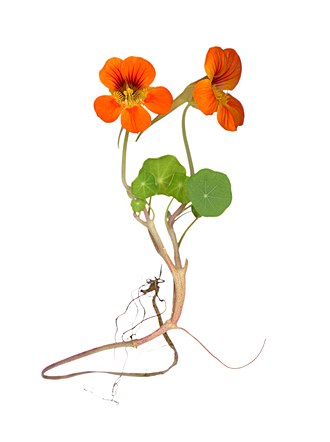Tropaeolum

Tropaeolum /trəˈpiːələm, troʊ-/,[1][2] commonly known as nasturtium (/nəˈstɜːrʃəm, næ-/;[3][4][5] literally “nose-twister” or “nose-tweaker”), is a genus of roughly 80 species of annual and perennial herbaceous flowering plants. It was named by Carl Linnaeus in his book Species Plantarum,[6] and is the only genus in the family Tropaeolaceae. The nasturtiums received their common name because they produce an oil similar to that of watercress (Nasturtium officinale).
The genus Tropaeolum, native to South and Central America, includes several very popular garden plants, the most common being T. majus, T. peregrinum and T. speciosum. One of the hardiest species is T. polyphyllum from Chile, the perennial roots of which can survive the winter underground at altitudes of 3,300 metres (10,000 ft).
Plants in this genus have showy, often intensely bright flowers and rounded, peltate (shield-shaped) leaves with the petiole in the centre. The flowers are bisexual and zygomorphic, with five petals, a superior three-carpelled ovary, and a funnel-shaped nectar spur at the back, formed by modification of one of the five sepals.[7]
Tropaeolum[which?] was first imported into Spain by the Spanish botanist Nicolás Monardes, who published an account in 1569 entitled Joyful News out of the Newe Founde Worlde in which he described, among other things, the plants and animals discovered in South America.[8] The English herbalist John Gerard reports having received seeds of the plant from Europe in his 1597 book Herball, or Generall Historie of Plantes.[9] Tropaeolum majus was named by the Swedish botanist Carl Linnaeus, who chose the genus name because the plant reminded him of an ancient custom: After victory in battle, the Romans erected a trophy pole (or tropaeum, from the Greek tropaion, source of English “trophy”) on which the vanquished foe’s armour and weapons were hung. The plant’s round leaves reminded Linnaeus of shields, and its flowers of blood-stained helmets.[10]
Nasturtiums were once commonly known as “Indian cresses” because they were introduced from the Americas, known popularly then as the Indies, and used like cress as salad ingredients. In his herbal, John Gerard compared the flowers of the “Indian Cress” to those of the forking larkspur (Consolida regalis) of the buttercup family.[10] He wrote: “Unto the backe part (of the flower) doth hange a taile or spurre, such as hath the Larkes heele, called in Latine Consolida regalis.”[9]
J. R. R. Tolkien commented that an alternative anglicization of “nasturtium” was “nasturtian”.[11]
Tropaeolum is a genus of dicotyledonous annual or perennial plants, often with somewhat succulent stems and sometimes tuberous roots. The alternate leaves are hairless, peltate, and entire or palmately lobed. The petioles or leaf stalks are long and in many species are able to twine around other stems to provide support. The flowers are bisexual and showy, set singly on long stalks in the axils of the leaves. They have five sepals, the uppermost of which is elongated into a nectar spur. The five petals are clawed, with the lower three unlike the upper two. The eight stamens are in two whorls of unequal length and the superior ovary has three segments and three stigmas on a single style. The fruit is naked and nut-like, with three single seed segments.[12][13]
